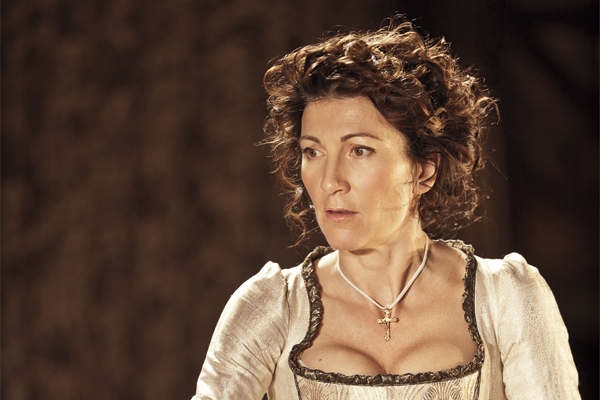John Webster had one amazing skill. He could craft lines that glow in the memory like radioactive gems. ‘A politician is the devil’s quilted anvil; he fashions all sins on him, and the blows are never heard.’ Eliot loved him. Pinter used to stroll around the parks of Hackney shouting his soundbites into the sky. But Webster never discovered how to put his highly wrought lines into the mouths of likable or captivating characters.
The Duchess of Malfi is a Jacobean slasher-play, a straight-to-video Tarantino blood-fest, full of cloaked assassins and scheming dukes. We’re in an Italian court where a beautiful noblewoman, played by Eve Best, has fixed her eye on a handsome young bumpkin. As soon as she arrives on stage, all merry smiles and lustful vitality, it’s clear she has the life expectancy of a choc-ice in the Sahara. Having married her nice-but-dim boyfriend she’s marked for death by her paranoid brothers. One is a tights-and-britches baddie who creeps in and out of the shadows leering and whispering. The other is a tart-tupping cardinal with a haughty manner and a candyfloss pink hat.
They hire various killers and a murder spree starts. It never stops. There’s a particularly unpleasant strangulation scene, grotesquely drawn out, in which limbs quiver and eyes roll madly, and the victim’s tongue flails and gropes at the air like a beached trout. A minor knifeman named Bosola (played with relentless dourness by Mark Bonnar) acquires a conscience towards the end and begins to show gleams of humanity. It all comes too late. The play culminates in a lengthy scene in which Bosola, and three other killers, writhe around on the floorboards stabbing each other while making the sort of speeches that characters in plays make while stabbing each other.









Comments
Join the debate for just £1 a month
Be part of the conversation with other Spectator readers by getting your first three months for £3.
UNLOCK ACCESS Just £1 a monthAlready a subscriber? Log in